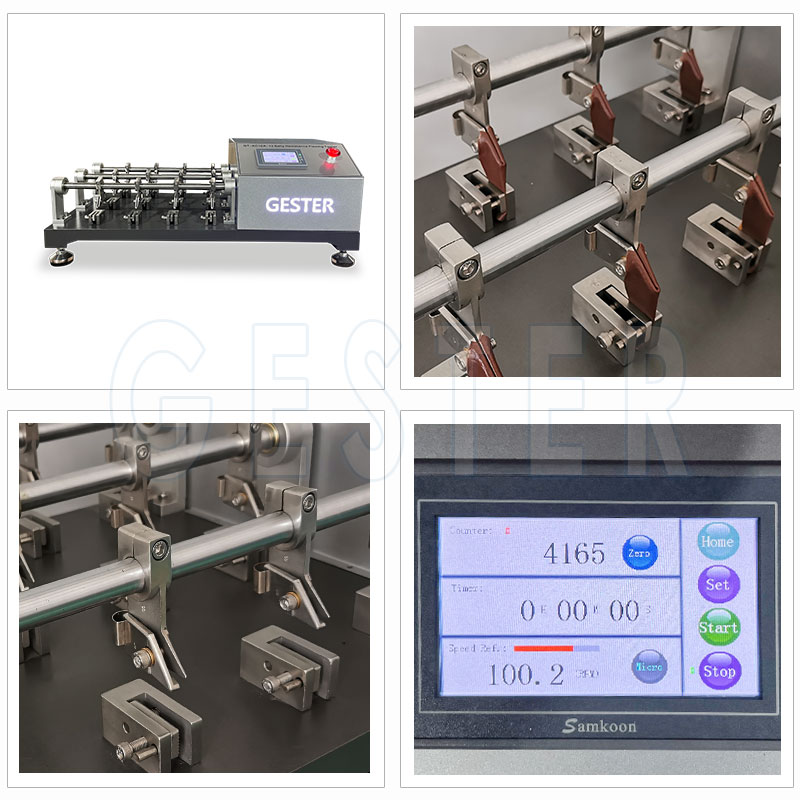How to Enhance Product Quality and Durability with
the Bally Leather Flexing Tester
Table of Contents
|
|
1. Introduction
2. Understanding Leather Quality
3. The Bally Leather Flexing Tester GT-KC10A
4. Applications
5. Advantages of the Leather Flexing Tester
6. Conclusion
|
Introduction
In the world of leather production, quality is paramount. Whether you are a leather goods manufacturer, a footwear designer, or an enthusiast of all things leather, you understand the importance of ensuring that the leather used in your products is of the highest quality. This is where the Bally Leather Flexing Tester GT-KC10A comes into play. In this comprehensive article, we will delve into the application, features, and benefits of this remarkable piece of equipment.

I. Understanding Leather Quality
Before we delve into the specifics of the Bally Leather Flexing Tester GT-KC10A, let's first establish why leather quality matters so much.
a. The Aesthetic Appeal: High-quality leather exudes a timeless elegance and sophistication that is unmatched by synthetic alternatives. The texture, color, and finish of leather are essential factors that contribute to its aesthetic appeal.
b. Durability: Leather products are often cherished for their durability. Quality leather can withstand years of wear and tear, making it an excellent investment.
c. Comfort: Leather's unique ability to adapt to the body's shape over time enhances comfort, making it a preferred choice for items like shoes, bags, and furniture.
d. Environmental Impact: Leather production can have significant environmental consequences. Investing in high-quality leather ensures that your products will last longer, reducing the overall environmental footprint.
II. The Bally Leather Flexing Tester GT-KC10A
Now that we have established the importance of leather quality, let's explore how the Bally Leather Flexing Tester GT-KC10A is helping manufacturers and enthusiasts alike in ensuring top-notch leather quality.
Unraveling the Technology
This Bally resistance flexing tester is used to determine the resistance of a material to cracking or other types of failure at flexing creases. The method is applicable to all flexible materials and in particular leathers, coated fabrics and textiles used in footwear uppers.
Key Features
Bally leather flexing tester: test specimen is folded in half then one end is secured in a clamp. The test specimen is then turned inside out and the free end secured in a second clamp at 90 degrees to the first. The first clamp is repeatedly oscillated through a fixed angle at a defined rate causing the test specimen to flex. At set intervals the number of flexing cycles is recorded and the damage to the test specimen is visually assessed. The bally flexometer test can be carried out with wet or dry test specimens at ambient.
III. Bally Leather Flexing Tester Applications
The Leather Flexing Tester finds application in various industries and scenarios:
a. Footwear Manufacturers: Shoe companies use the bally flexometer to test the durability of leather used in shoe uppers and soles. This ensures that their products withstand the rigors of daily wear.
b. Furniture and Upholstery: Manufacturers of leather furniture and upholstery use the device to assess how leather will perform under constant use, guaranteeing longevity and comfort.
c. Leather Goods: From handbags to wallets, quality leather is essential for crafting luxury leather goods. The bally test machine helps ensure that these items stand the test of time.
d. Research and Development: Leather researchers use the GT-KC10A to study the effects of different tanning methods and treatments on leather quality.

IV. Advantages of the Leather Flexing Tester
a. Improved Quality Control: By subjecting your materials to rigorous testing with the Leather Flexing Tester, you can identify potential issues early in the production process. This empowers you to make necessary adjustments and maintain a higher level of quality control.
b. Enhanced Durability: With precise testing data at your disposal, you can make informed decisions about the materials you use in your products. This can lead to the selection of more durable materials, ultimately resulting in longer-lasting and more robust finished products.
c. Cost Savings: Identifying weaknesses in your materials before they make it into the final product can save you money on returns, repairs, and replacements. It also helps avoid potential liabilities associated with product failures.
V. Conclusion
In a competitive market where quality and durability are paramount, the Bally Resistance Flexing Tester stands as a crucial tool for manufacturers and product developers. Its ability to accurately assess materials for resistance to cracking and other forms of failure sets it apart as an indispensable asset. By incorporating this equipment into your testing and quality control processes, you can not only improve the quality and durability of your products but also save costs and enhance customer satisfaction.



